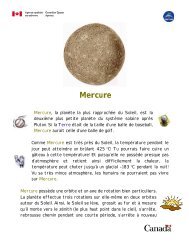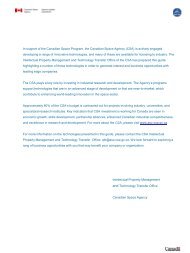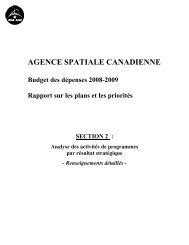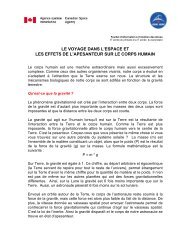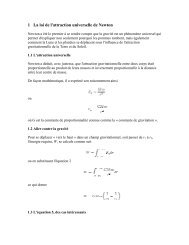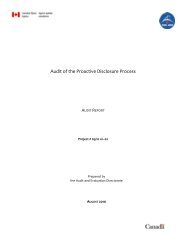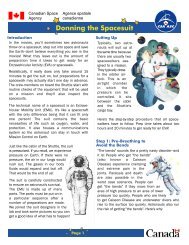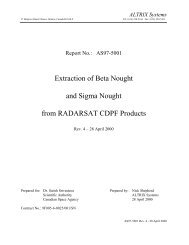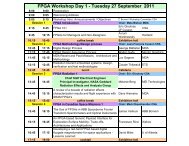PDF version of COSPAR - Space Science Research in Canada Report
PDF version of COSPAR - Space Science Research in Canada Report
PDF version of COSPAR - Space Science Research in Canada Report
Create successful ePaper yourself
Turn your PDF publications into a flip-book with our unique Google optimized e-Paper software.
At the same time, <strong>Canada</strong> is an active participant <strong>in</strong> <strong>in</strong>ternational programs, andcontributes both technology and scientific expertise to study<strong>in</strong>g globalenvironmental and resource issues. For example, data gathered by MOPITT, aCanadian-built <strong>in</strong>strument carried on a NASA satellite, is be<strong>in</strong>g used to map howpollutants migrate around the planet.The data produced by CSA’s EO thrust are <strong>in</strong>tended to assist the government <strong>in</strong>policy-mak<strong>in</strong>g and provide Canadians with tangible benefits. <strong>Space</strong>-basedobservations are crucial to a wide range <strong>of</strong> economic, environmental and securityservices: from forecast<strong>in</strong>g the weather, monitor<strong>in</strong>g sensitive ecosystems, andmanag<strong>in</strong>g forests, to provid<strong>in</strong>g ice monitor<strong>in</strong>g and mapp<strong>in</strong>g, surveillance <strong>of</strong>coastal waters, and protect<strong>in</strong>g people and <strong>in</strong>frastructure from natural hazardsand help<strong>in</strong>g them recover from disasters.Earth observation data play a significant role <strong>in</strong> measur<strong>in</strong>g air and water qualityand pollution levels, and enhance <strong>Canada</strong>’s ability to employ susta<strong>in</strong>ablemanagement <strong>of</strong> its natural resources, fisheries, agriculture and land use—foursectors that generate more than 42% <strong>of</strong> the country’s exports and account for14% <strong>of</strong> Gross Domestic Product.The EO thrust is particularly significant for understand<strong>in</strong>g, monitor<strong>in</strong>g andmanag<strong>in</strong>g <strong>Canada</strong>’s most challeng<strong>in</strong>g environments: the North and its extensivecoastl<strong>in</strong>e—the longest <strong>in</strong> the world. These vast regions, conta<strong>in</strong><strong>in</strong>g relatively little<strong>in</strong>frastructure, are difficult and expensive to monitor us<strong>in</strong>g technologies based onEarth.The EO thrust also play a key role <strong>in</strong> help<strong>in</strong>g <strong>Canada</strong> meet its needs forsurveillance and law enforcement on land, <strong>in</strong> coastal waters, and at its borders.EO data are also useful to support foreign policy <strong>in</strong>itiatives, such aspeacekeep<strong>in</strong>g activities, treaty verification, and deliver<strong>in</strong>g humanitarian aid.<strong>Space</strong> <strong>Science</strong> and ExplorationAt the heart <strong>of</strong> the CSA’s <strong>Space</strong> <strong>Science</strong> and Exploration thrust are these threeobjectives:• To better understand the solar system and the universe;• to seek signs <strong>of</strong> life <strong>in</strong> extraterrestrial habitats; and• to prepare for permanent human presence <strong>in</strong> spaceand on other planets.7



